What is Art Deco?
Art Deco started to appear in Europe as early as World War I but rose to prominence in France during the 1920s. Its name is a short form of Arts Décoratifs which was taken from the Exposition Internationale des Arts Décoratifs et Industriels Modernes (International Exhibition of Modern Industrial and Decorative Arts) which was held in Paris in 1925.
Art Deco totally dominated the European art world in the 1920s and 30s and then celebrated a brief resurgence in the 1960s. It embraced technology and bold, abstract shapes, setting it clearly apart from its predecessor Art Nouveau with its soft lines and focus on nature and mythology.
In America, famous architectural examples of Art Deco include the Empire State Building, the Chrysler Building, Radio City Music Hall, and Rockefeller Center, all in New York City. These buildings also served as showcases for Art Deco sculptural and decorative art. But American Artists did not just follow their European peers, they created their own styles: Zig Zag style, Streamline Moderne, Prairie School can all be seen as offshoots or overlapping Art Deco styles.
The most famous examples of Art Deco medallic art are probably French and Belgian, but American artists can certainly compete in the master category. Some of their works are selected for display in the Medals section.
As always, click or tap on medals to see their reverse side and slide them to see variants (where available).


The obverse bears two stylized figures whose posture indicates that they are dead or dying. They are surrounded by bold diagonal lines lending depth and perspective to the arrangement.
The reverse bears incuse triangle with text: Dem lebenden / Geiste / unserer / Toten / 1914 / 1924; signed at bottom, ENCKE
The edge is marked AKT-GES. GLADENBECK
Eberhard Encke was a German sculptor who does not really fit in with the rest of the artists/medals on this site but I was very impressed by this medal, particularly given its creation date. It is a very early German example of a style that includes many of the elements that define art deco: stylized figures and bold geometric elements.
The legend translates to: To the living spirit of our dead 1914 - 1924.
The circular medal measures 76mm and was produced by the Aktiengesellschaft Gladenbeck.
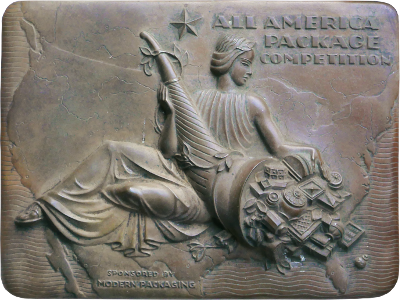
The uniface plaque bears lounging young woman holding cornucopia filled with consumer goods; behind her, map of continental United States with major rivers; star above. At top right, ALL AMERICA / PACKAGE / COMPETITION; at bottom, SPONSORED BY / MODERN PACKAGING; signed below cornucopia, GERTA RIES
Modern Packaging was a professional magazine targeting, who would have guessed it, the packaging industry. Sometime in the 1920's or 30's they had a national competition for innovative packaging solutions. Most likely, this plaque was used as an award for the winners of the competition.
This is one of my favorite commercial plaques. Gerta Wiener signed it with her maiden name "Ries", so she was probably early in her career when she received this commission. The plaque's very high, art deco style relief and clear lines make it stand out among its peers, both literally and figuratively.
I would welcome more information about this plaque, particularly about the foundry and the dates of plaque and competition.
This rounded rectangular plaque measures 224mm x 168mm and was cast in bronze.


The medal's obverse bears art deco style bust of a pilot in a leather flying helmet with laurel leaf crown, up-turned wings behind pilot, star above. To left and right of pilot, around edge, THE OLYMPIAD - OF THE AIR; signed at lower left, OSKAR J W HANSEN Sc.
The medal's reverse bears relief of two art deco style winged pilot figures in flight above tower. Above, CHICAGO; Along background arc, 1930 NATIONAL - AIR RACES - 10TH ANNIVERSARY
Oskar Hansen (1892-1971) designed this art deco bronze medal to celebrate the 1930 National Air Races that took place in Chicago. It was the 10th anniversary of the races and the first year for The Thompson Trophy. Hansen is best known for his bronze works in connection with The Hoover Dam.
This medal measures 63mm (2.5in) in diameter and was struck by the Medallic Art Company of New York.
All that being said, this is a fairly rare medal that typically trades on eBay between $100 and $300.
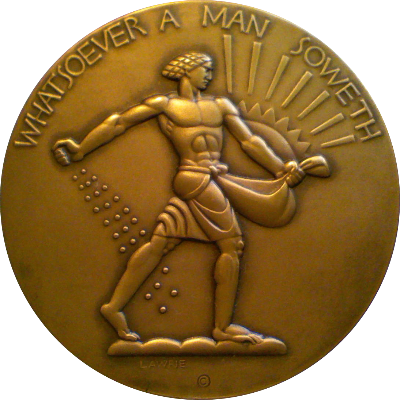
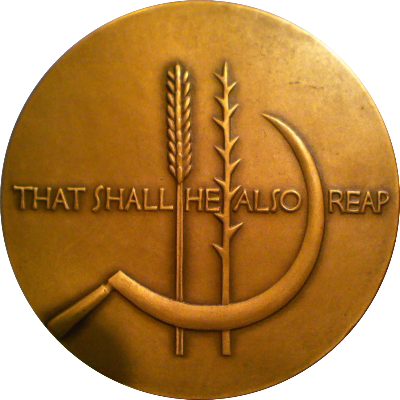
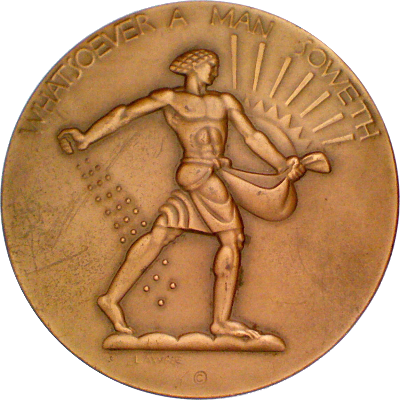
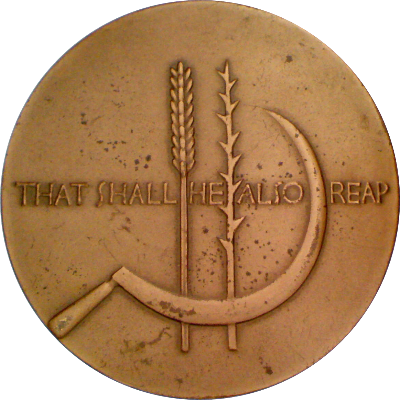
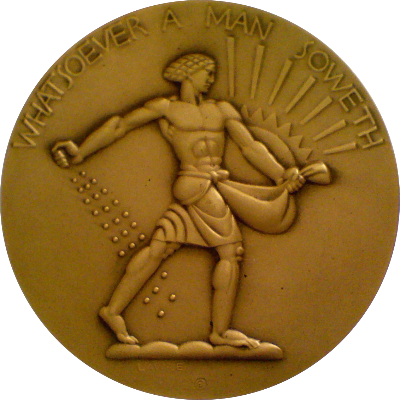
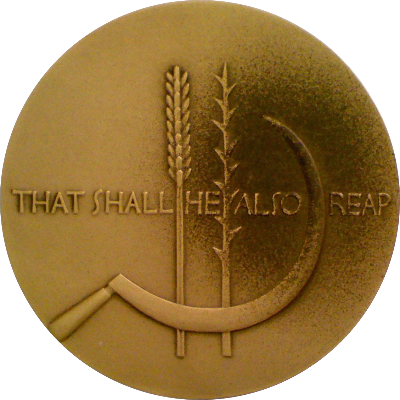
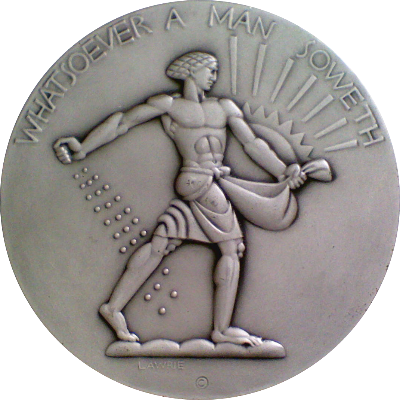
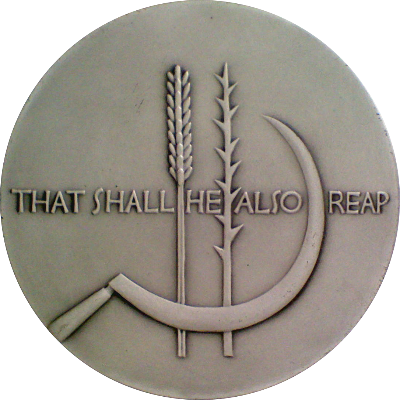
This medal was chosen as the fifth issue of the prestigious Society of Medalists series in 1932. The obverse bears a sower scattering seeds under a stylized sun. Above, WHATSOEVER A MAN SOWETH; in exergue, LAWRIE / © The reverse bears a sickle poised over a wheat ear and a nettle. Across, THAT SHALL HE ALSO REAP
Lee Lawrie was fascinated by the sower and reused this motif time and again in many projects. Originally conceived for the Nebraska State Capital, where it adorns the dome in the form of a giant statue, he also used it on the Rockefeller Center in New York. In the artist's own words:
"All of us are sowers, and we should not expect life to yield much in return for little, or little for nothing, or anything at all for the mere wishing - either in a material or in a higher, abstract way."
The medal measures 73mm in diameter and was struck by the Medallic Art Company of New York. The reported production quantity is 1,617 in bronze and 35 in silver.
References: Marqusee 241
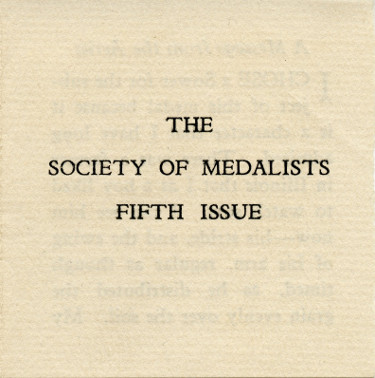
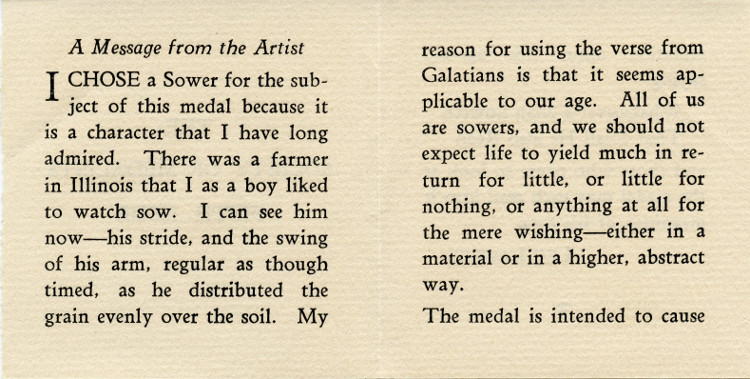
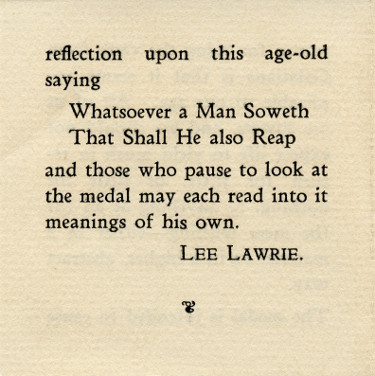


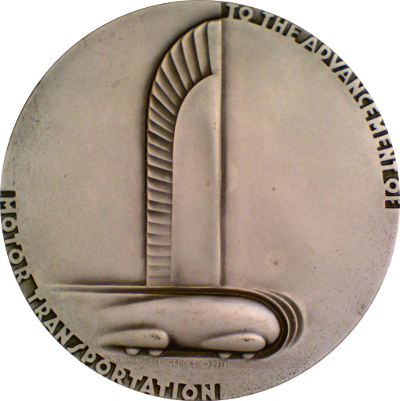

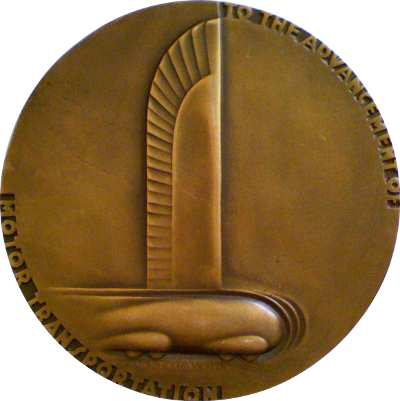
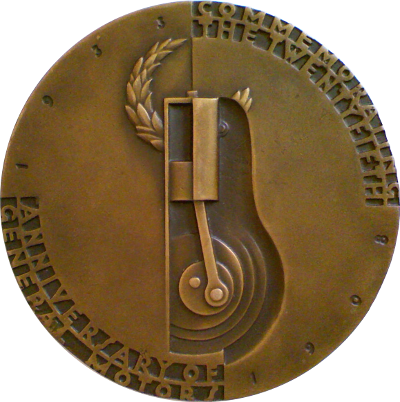
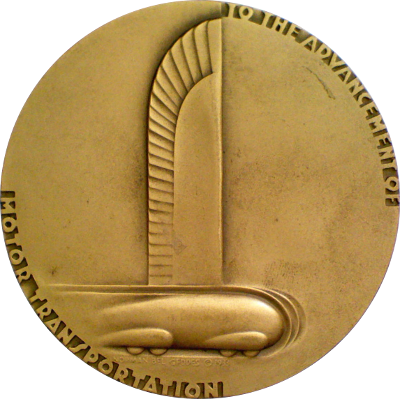
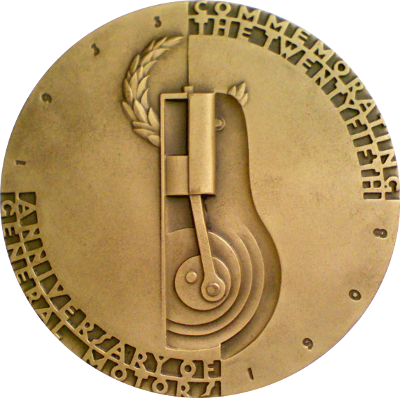

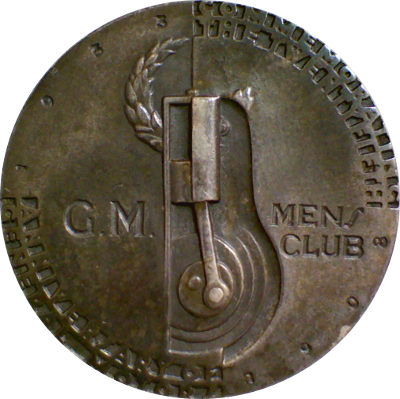
The obverse bears a streamlined car with stylized wing extending vertically up. Top right and bottom left, TO THE ADVANCEMENT OF - MOTOR TRANSPORTATION; signed under car, NORMAN BEL GEDDES © 1933. The reverse bears a stylized piston and laurels. Around in four quadrants, COMMEMORATING / THE TWENTYFIFTH - ANNIVERSARY OF / GENERAL MOTORS - 1908 - 1933.
This iconic machine-age medal is a perfect example of the Streamlined style that dominated architecture and design in America from the late 1920s to the end of the 1930s. It was designed by Norman Bel Geddes but sculpted by Rene Paul Chambellan. Its main variant was commissioned by General Motors to be distributed during its 25th Anniversary celebrations and at the 1933 Chicago World Fair of Progress.
The General Motors romance brochure that accompanied some medals included the following words about the design:
"The face of the medal shows a speeding automotive body behind which a wing rises perpendicularly. Since the medal is to be used as an award in future years and the car of the future is merely a guess, this car is an abstract streamline form without doors or windows. The conventionalized wing symbolizes General Motors interest in air transportation. The wing being static; the car, by contrast, seems to move more swiftly ... The reverse of the medal shows a combustion chamber ... since it is the heart of the motor. It too has been conventionalized."
The medal was manufactured in different variants. The relatively common ones measure 76mm in diameter and are struck in bronze or silver-plated bronze. The large silver-plated medal is the most common variant. The bronze and the smaller 38mm and 29mm variants are much less common. The smallest was inscribed across the reverse G.M. - MENS / CLUB and only given to GM executives. In the thirties it was of course a fairly safe bet that executive positions would be limited to men. A mounted plaque version measuring 9 inches in diameter was given to some dealers in the 1950s.
Completely intact silver-plated variants are hard to come by; the silver layer did not stand the test of time on most pieces and it is almost unheard of to see one without at least rubbing on high points.
Just as the design is unmistakably Bel Geddes, the execution is unmistakably Chambellan. Before I knew that it was a Bel Geddes, I would have guessed it to be a Chambellan based on its lettering alone.
The medal was struck by the Medallic Art Company of New York.
All that being said, prices for this medal vary even more widely based on quality and venue. Small antiques boutiques frequently offer the 76mm silver-plated pieces at prices over $2,000. Of course I do not know what prices are actually realized. On eBay, the 76mm medals frequently trade between $800 and $1,500 and I have not yet seen the smaller ones come up there.

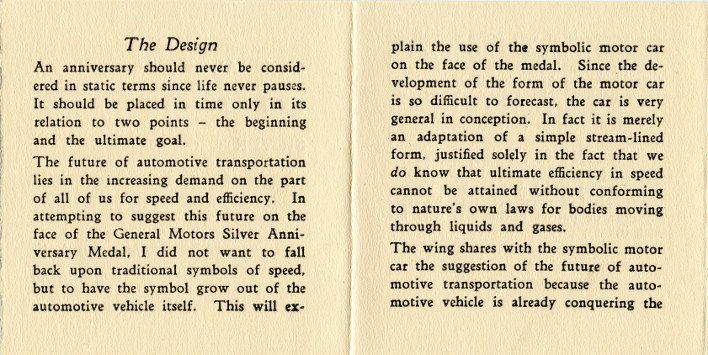
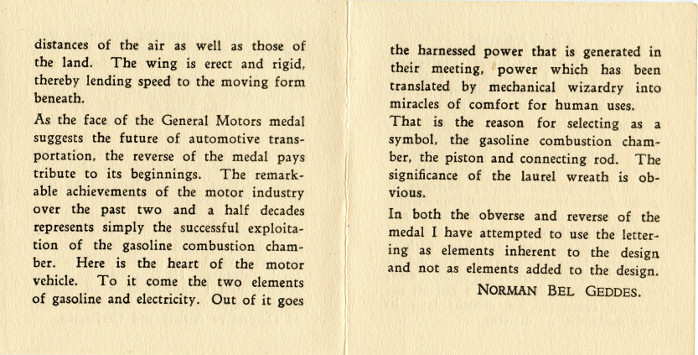


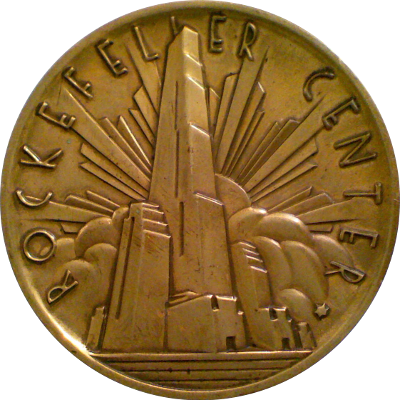
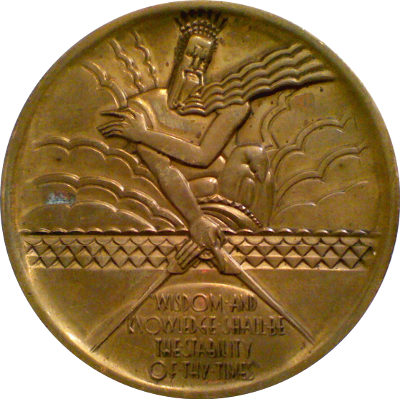
The obverse bears classic art deco view of building with sun behind and clouds on sides. Around, ROCKEFELLER CENTER.
The reverse bears medallic version of Lawrie's bas-relief panel on face of Rockefeller center. God with crown and long wavy beard frowning from sky. Below, WISDOM AND / KNOWLEDGE SHALL BE / THE STABILITY / OF THY TIMES.
The medal measures 70mm in diameter and was struck by the International Silver Company.




The obverse bears the old NBC logo crisscrossed in the center; double lightning bolts extending from all corners of the cross. On left and right of lightning bolts above, 19 / 26; on left and right of lighning bolts below, 19 / 36.
The reverse bears text only. Around, NATIONAL BROADCASTING COMPANY * A RADIO CORPORATION OF AMERICA SERVICE * ; in center field, TENTH ANNIVERSARY / TO THOSE WHO HAVE SHARED WITH US / IN THE ADVANCEMENT OF BROADCASTING.
The medal commemorates the tenth anniversary of the National Broadcasting Company which was founded in 1926. It was distributed to its employees in 1936. From Chris Bach, whom I owe big thanks for information about art medals, I learned the following:
This scarce Art Deco medal has long been "unsigned" in various auctions with no artist or sculptor identified or credited with the design. However, the Cleveland Museum of Art credits the medal as being a collaboration of three people: "modeled by Julio Kilenyi (American, b. 1885); obverse designed by Richard A Loederer (American, b. 1894) and the reverse designed by E.P.H. James (American)" - a gift to the museum's collection by the National Broadcasting Company in 1937 (No. 1937.9.A/B). A specimen at the New York Historical Society in NYC also credits Julio Kilenyi; and the Library of Congress collection identifies a similar item designed by Loederer in their NBC History Files: 1922-1986, Folder 173, Logos, "Photo of tenth anniversary (1936) plaque designed by Richard Loederer of Vienna."
This medal measures 76mm in diameter and was struck in bronze by the Robbins Company of Attleboro, Massachusetts.
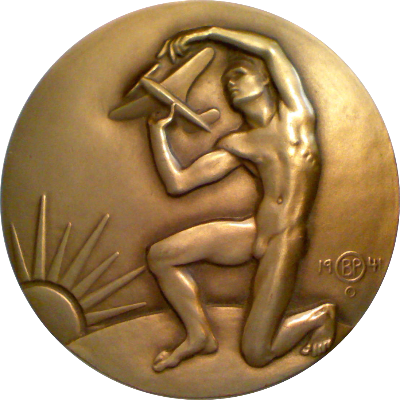

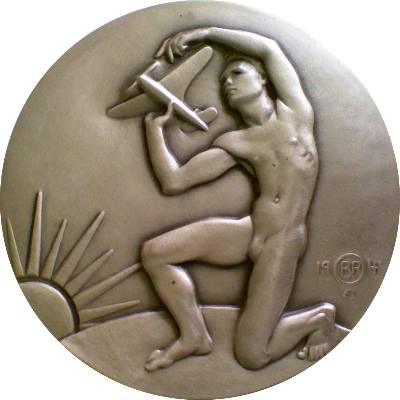

This medal was chosen as the 26th issue of the prestigious Society of Medalists series in 1942.
The obverse bears kneeling nude youth holding an airplane model in right hand, left hand on propeller; sun at left horizon. To right, date and signature 19 (circled BP) 41 / ©
The reverse bears dove in flight over fleecy clouds. Below, FLIGHT
Brenda Putnam wrote in the brochure accompanying the medal:
"Although this medal is issued during a preiod when the entire world is engaged in a gigantic struggle on land, at sea, and in the air, the theme of the medal is not warlike. The lad is no warrior, and the bird no eagle. Rather does the design concern itself with man's creative struggle to win supremacy in a vast new region, -the air. The war proves only too well the appalling destructive power of fighting and bombing planes. But beyond the war -and there will surely be a beyond- there are infinite possibilities for constructive and humanitarian activities in man's conquest of the air."
This medal measures 73mm in diameter and was produced by the Medallic Art Company of New York which struck 759 pieces in bronze and 100 in silver.
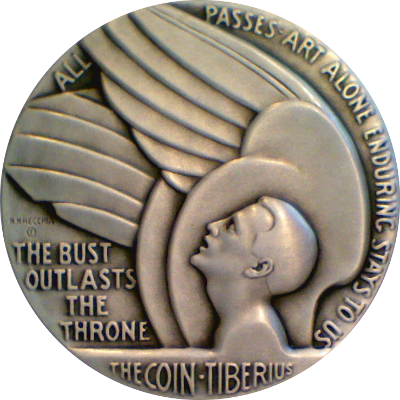
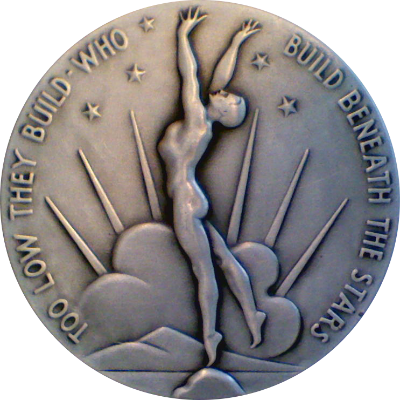

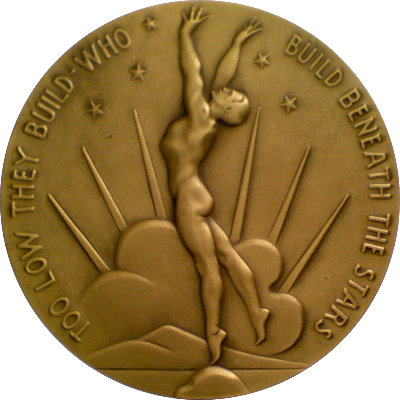
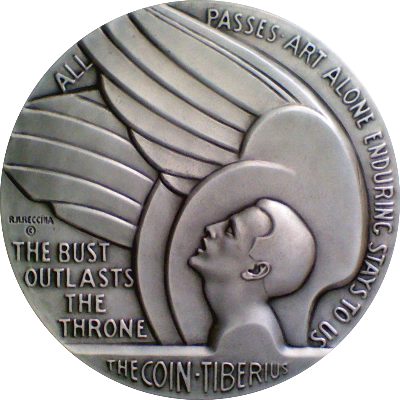
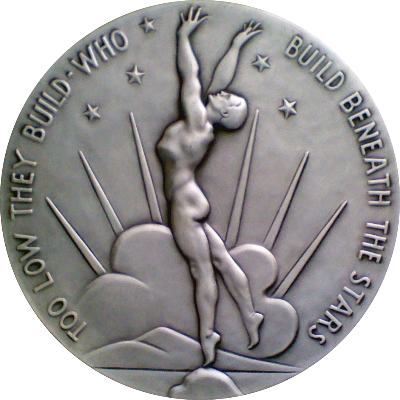
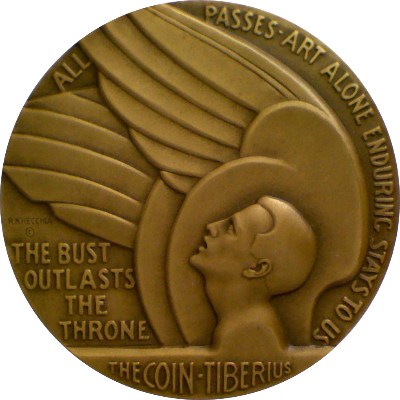

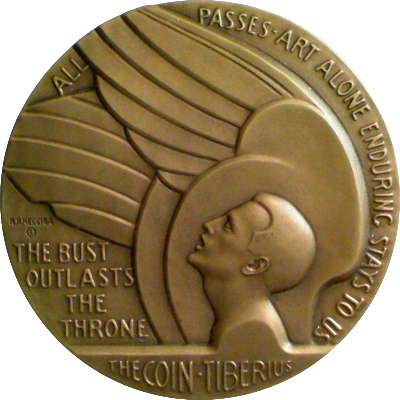
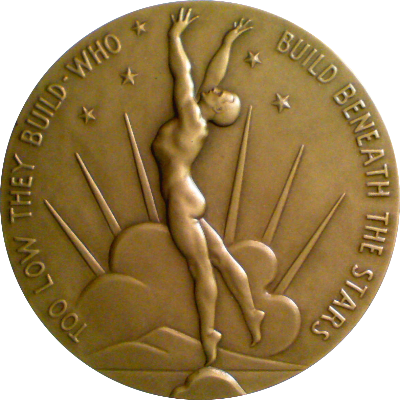
This medal was chosen as the 29th issue of the prestigious Society of Medalists series in 1944. The obverse bears herm-type male bust facing upward against massive stylized wings. Around, ALL - PASSES ART ALONE ENDURING STAYS TO US; in lower left field, THE BUST / OUTLASTS / THE / THRONE; in exergue, THE COIN TIBERIUS; at left, incuse, R.H.RECCHIA / ©
The reverse bears nude youth leaping with outstretched arms into starry sky; hills clouds, and rays in background. Around, TOO LOW THEY BUILD WHO - BUILD BENEATH THE STARS
This medal is one of the two war-time SOM medals that were originally struck in silver because copper was largely dedicated to war needs. Apparently, 57 50mm-diameter pieces were struck in bronze but even long-time collectors have not seen any. Some were later struck in the 1970's.
Recchia drew his own inspiration for this medal from poetry, namely Austin Dobson's "Ars Victrix' for the quotes on the obverse and Edward Young's "Night Thoughts" on the reverse. Recchia wrote in the brochure accompanying the medal:
"The bust ... shows the man's mind stretching upwards, to and beyond the flight of the wings of imagination and passing time and depicting man's dreams of seeking higher realms of inspiration."
Recchia's combined message was devoid of war-time propaganda and very humanistic at its core. Or maybe the very fact that it was so humanistic made it a very effective war-time message for an audience that was fighting for the survival of western civilization.
On a personal note, this is the medal that inspired me to become a medal collector when I first saw it on display at the Yale University Art Gallery. To this day, it remains one of my favorite art medals.
This medal was first produced in 50mm and was struck in silver by the Medallic Art Company of New York. OVerall, the reported production quantity of this medal is 891 small-diameter silver, 57 small-diameter bronze, 150 large-diameter bronze, and 100 large-diameter silver.
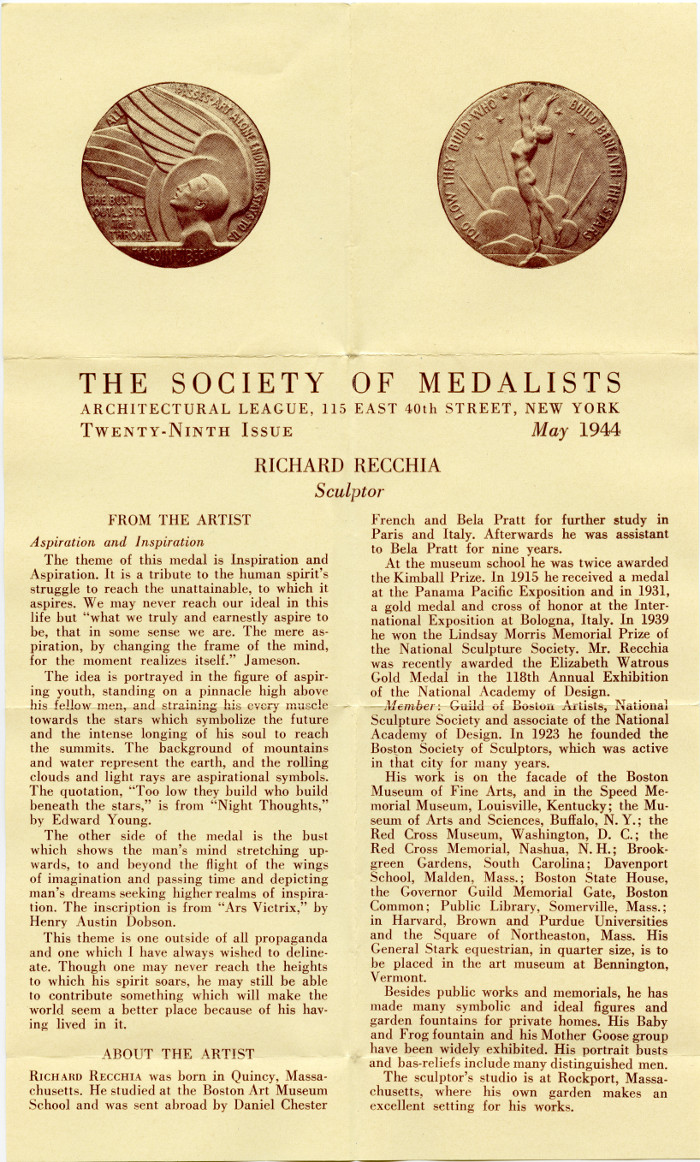
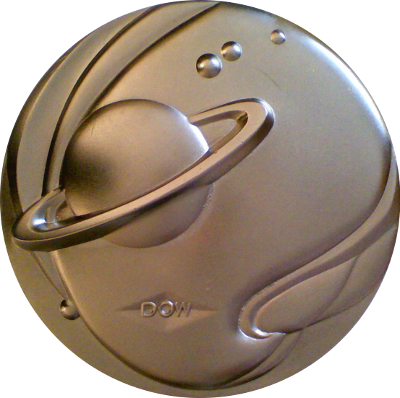

This unusual medal celebrating Dow Chemicals' fiftieth anniversary is struck in a manganese alloy developed by Dow Chemicals in the 1940's. The obverse bears Saturn and moons over swirling galaxy. Lower left DOW. The reverse bears upright hand holding leaf over stylized sun. Around, FIFTY YEARS OF CREATIVE DEVELOPMENT / 1897 - 1947.
Marshall Fredericks designed this elegant medal in a style that is reminiscent of de Francisci's Fiat Vita medal, yet simpler and more abstract.
The medal measures 76mm (3in) in diameter and was struck by the Medallic Art Company of New York.